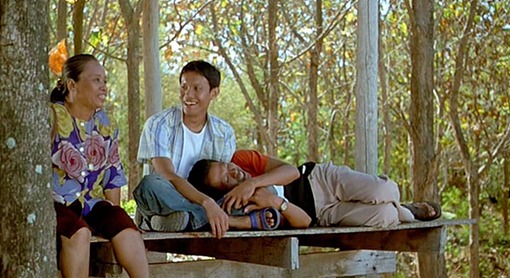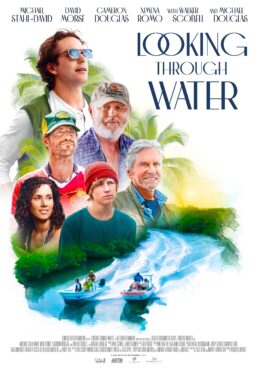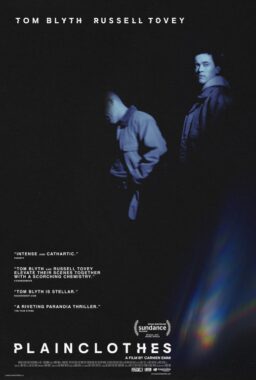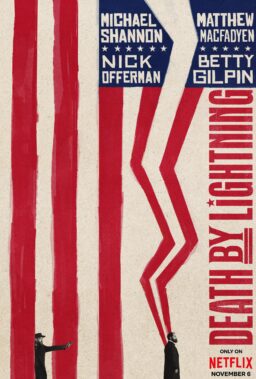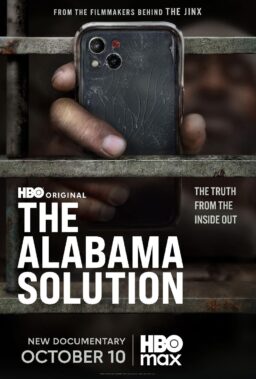For the last month, I’ve been watching almost nothing but Abbas Kiarostami and Apichatpong Weerasethakul movies — and it’s been the best run of good-to-great movie-watching I’ve had in years. How did this happen? Well, I was beguiled by their most recent pictures: Kiarostami’s “Certified Copy” and Weerasethakul’s “Uncle Boonmee Who Can Recall His Past Lives” — both prize-winners at last year’s Cannes Film Festival (best actress for Juliette Binoche, and the Palm d’Or, respectively). For reasons I’ll get into in a bit, the only Kiarostami’s I’d seen before were two of his biggies, “Taste of Cherry” (1997) and “The Wind Will Carry Us” (1999); and the only Apichatpong (just call him “Joe”) movie I’d seen was “Blissfully Yours” (2002).
The films of both these directors have been widely (mis-)characterized as “difficult” (please see Girish Shambu’s excellent rumination on that term here, if you haven’t already), but that’s not why it’s taken me so long to familiarize myself with more of their work. I don’t have any good reasons, but I’ll be honest: I was put off by the critical hype for Kiarostami, which in the art-cinema world was exceeded (in my perception) only by that for Quentin Tarantino in the pop-art-cinema world. Also, I remember the press screening for “The Wind Will Carry Us” at the Toronto Film Festival and, during the final shot (which was nice but a little too on-the-nose for me), a critic behind me let out a rapturous sigh intended to be overheard by everyone in the vicinity: “Masterpiece!” I admit (I’m only human) that made me a little nauseous, and some of my critic friends who were much more involved in the festival scene than I was at the time were outspoken Kiarostami naysayers, so I didn’t feel particularly motivated to seek out more of his work.
I appreciated the Kiarostami I’d seen (except, notably, for the controversial video coda of “Taste of Cherry,” which still strikes me as a cheap and gimmicky cliché — undercutting the dark ambiguity of the images leading up to it — rather than reflexively “life-affirming”), but there were plenty of outspoken Kiarostami partisans at the time, and the more breathless prose I read about him as a lover and liver of “life” in cinema, the more I was inclined to look elsewhere for challenging filmmaking. (I know: It was a knee-jerk contrarian reaction, but I’m owning up to it now and I feel it was largely mistaken on my part.)
As for Joe (that’s what he says he wants us to call him), I have no explanation other than my own ignorance and sloth. I had “Tropical Malady” (2004) in my Netflix queue for the longest time and I honestly don’t know how I missed “Syndromes and a Century” (2006) in Toronto, especially when wiser film-friends like Girish were so enthusiastic about it.
But that’s all water under the bridge. I still have a lot more to see — and I’m looking forward to it — but before I went to the Conference on World Affairs in Boulder last week (where I was once again thrilled and honored to moderate the Ebert Cinema Interruptus all week — going through the Coens’ masterpiece “A Serious Man” shot-by-shot with the audience for a total of eight hours, in four two-hour sessions) I caught up with Kiarostami’s “Koker Trilogy” — “Where Is the Friend’s Home?” (1987), “Life, and Nothing More…” (1992), “Through the Olive Trees” (1994) — and “Close Up” (1990); and Weerasethakul’s “Tropical Malady” and “Syndromes and a Century.” (I just got ahold of “Mysterious Objects at Noon,” his take on the Surrealist technique known as Exquisite Corpse, but I haven’t looked at it yet.)
So, what I’m leading up to is that from the movies mentioned above, I see both these writer-directors as fundamentally comedic filmmakers, who use conventional narrative techniques of suspense to tell stories that, on the surface at least, appear less than conventional. “Where Is the Friend’s Home?” is a Keatonesque physical comedy (those wonderfully funny long takes of the zig-zag path up the hill between the villages find their expression in Kiarostami again in the search for cell-phone signals in “The Wind Will Carry Us”), which is built around the simplest of premises: a boy accidentally takes a friend’s homework notebook home with him after school and must find a way to return it to him before the teacher finds out and expels the friend.

Compared to Keaton’s dry-eyed existentialism, however, Kiarostami is downright sentimental. And although he’s been celebrated for his embrace of “ambiguity,” the term has often been misapplied to his endings (especially when compared to the far bolder and more challenging life-and-death ambiguities of the Coens in, say, “No Country for Old Men” or “A Serious Man” — which I mention only because I went from immersion in one directors’ movies to another’s). Let’s take the final shot of the second Koker film, for example. A film director (stand-in for Kiarostami) and his young son drive to Koker after the 1990 Manjil-Rudbar earthquake in search of the boy who had played the lead in his film, “Where Is the Friend’s Home?”

Kiarostami said the film was a fictionalized re-enactment of his own journey to find out what happened to the boy after the earthquake, but as the film goes on it becomes less about the fate of the boy than about the director-character’s determination to get to Koker. In the final shot (of another zig-zag road up a hillside), the director character finally engages with a man carrying a heavy canister and offers him a ride. The fate of the boy remains ambiguous, but the film offers a sense of emotional fulfillment: the quest continues. (OK, I have some moral qualms about this, but in the film’s terms, it works.)
Part Three of the so-called Koker trilogy is ostensibly about the making of Part Two. In my estimation, “Through the Olive Trees” is a more resonant (and funnier) film than “Life, and Nothing More…” — although, once again, it makes the director himself (this time played by another actor, directing the actor who played the director in the earlier film) as a wise, interventionist god-figure. The comedy-within-the-comedy this time involves the shooting of a scene in “Life, and Nothing More…” in which a man named Hossein (played exquisitely by Hossein Rezai, the Iranian Bruno Kirby) explains how he got married after losing many relatives and future in-laws in the quake.

In “Through the Olive Trees,” Hossein wants to marry the woman who plays his newlywed wife, but she will hardly speak to him. In the celebrated final shot (lasting many minutes), he follows her down a hillside, through a grove of olive trees, and into a distant field before she finally acknowledges his presence. They are mere dots on the screen, but there is no ambiguity (despite what some critics will tell you) about the outcome. NO ambiguity. The dots stop, the music ceases, then resumes, shifting into a celebratory mode. Hussein runs back toward the camera, still positioned high on the hillside, cutting through the grass and falling down. You’d have to be deaf, dumb and blind not to understand what the film is saying at this point. It’s a lovely, thrilling ending. It’s just not “ambiguous” and I don’t know why some insist on reading it that way. (See the illuminating discussion between Mehrnaz Saeed-Vafa and Jonathan Rosenbaum at senses of cinema.¹)
Maybe it’s just that I’m looking at these films (and “Close Up”) from the perspective of 2011 rather than the times in which they were made and originally released, but these Kiarostami pictures seem entirely conventional to me — and that’s no slight. They are solidly constructed narratives (just as the three riders in “A Taste of Cherry” — the Kurdish soldier, the Afghan seminarian, the Azeri taxidermist — provide the film with the semblance of a familiar three-act structure) that rely on traditional principles of storytelling suspense: Will the boy be able to return the notebook to his friend in time for school tomorrow? Will the director be able to find out what happened to the boy who starred in the previous movie? Will the actor be able to persuade the actress to marry him? Will the director ever get that long take he inexplicably wants from Hossein and his off-camera “bride”? (And we know he didn’t even use this angle, because we’ve already seen the movie he’s now shooting in a fictionalized version of the making of the earlier one. Poetic license, I suppose…) To Western eyes (which are obviously the only eyes I have), it’s lovely, subtle genre filmmaking: slapstick comedy, sentimental drama, romantic comedy. It might be something else, too, but it’s definitely those things.
My friend and cinematic guru David Bordwell recently posted a piece he titled “Arthouse suspense, in big and small doses,” which serendipitously connected to some of my thoughts in recent weeks regarding my experience with Kiarostami and Apitchatpong (and the Coens):
Suspense is usually associated with popular plotting, so many people expect Serious Films to be lacking in suspense. Which makes it all the more interesting that Iran, one of the most-favored nations on the festival circuit, has made something of a specialty of suspenseful art movies.
We don’t recognize often enough that Kiarostami’s early films are often structured as suspenseful quests, from the boy’s attempt to return his schoolmate’s notebook in “Where Is the Friend’s Home?” to the final shot of “Through the Olive Trees.”
Yes! “Close Up” (Based on a True Story) begins with the arrest of a man for impersonating Iranian film director Mohsen Makhmalbaf (we stay outside with a cab driver), then follows the trial (as Kiarostami did), with flashbacks to illustrate the testimony. It’s a clever reflexive touch that several of the major characters are playing themselves, but as a story it works like gangbusters, regardless: Who is this guy? Why is he doing what he’s doing? What does he want? How long will he get away with it? What do others want from him, and why do they go along with it? And so on and so on.
Even “Certified Copy” becomes a tale of suspense, as a conversation between a man and a woman evolves into an ever-deepening mystery: What is the nature of their relationship, and how is it changing? Questions like those keep me on the edge of my seat.
Kiarostami has been hailed as a stylist (long takes, often with the camera locked down in/on a car) and a humanist, and although I’ve read that his 21st century films have tended toward the “experimental” (“Ten,” “ABC Africa,” “Five,” “10 on Ten,” “Shirin”), these earlier pictures offer stories, characters, visual pleasures and cinematic grammar that are fully accessible and not at all unfamiliar.
In his post on “Difficult Cinema,” Girish writes:
I recently watched “Andrei Rublev” (1966), a remarkable and quintessential work of cinematic modernism. It can be called difficult for many reasons: it’s three and a half hours long; the narrative is episodic and discontinuous; the film is structured in the form of chapters but often there is little idea of how much time has elapsed between them; there are dozens of characters, and the relationships between them are not always clear; to complicate matters, the same actors turn up in multiple roles through the film; Tarkovsky frequently drops narrative and character in order to focus on the elements (earth, air, water, fire) in an immersive, tactile way. In and beyond matters of plot, action, character and psychology, Tarkovsky poses challenges to interpretation, especially given the central theme of the spiritual — the non-material, the intangible — that runs through the film.
The only Tarkovsky film I recall feeling was truly difficult was (as I’ve written before) “Nostalghia” — as in difficult to sit through and still remain breathing, especially during the bit with the candle that keeps going out, requiring the scene to repeat itself again and again (not unlike the attempts to shoot the scene between Hossein and his bride — but without humor). Again, maybe it was the cramped, hot, stuffy conditions under which I saw it at the Telluride Film Festival that year, but I did not relish the experience.
I guess you could apply the term “difficult” to Apichatpong Weerasethakul films — or just his name, which is why he prefers “Joe” — but I just watched three (“Tropical Malady,” “Syndromes and a Century” and “Uncle Boonmee Who Can Recall His Past Lives”) with a big silly grin on my face, absolutely entranced at their warmth, humor and vibrant physical presence — those colors, shapes, textures, landscapes, faces…
Sam Adams recently introduced an A.V. Club interview with Joe in splendidly evocative fashion:
The films of Thai-born, Chicago-educated filmmaker Apichatpong Weerasethakul defy easy explanation, but that doesn’t mean they’re difficult to watch. There are few filmmakers whose work so purely radiates the joy of creation, and who express a more palpable sense of engagement with the world around them. His films contain shreds of plot, but following them only leads to confusion. They are better understood as sensory experiences, structured according to the fluid logic of memory and held together by threads of desire.
Like Kiarostami, Joe is no doubt a serious man and a fine artist. And I can’t help but view his films as deeply comedic reveries — even when they’re about the slow descent into death or boyfriends who turn into tiger spirits.
There’s a moment in the Coens’ “A Serious Man” when the film starts to peel apart. Not for the first (or last) time, we see Larry Gopnick waking up in the room he shares with his brother Arthur at the Jolly Rodger Motel. In the dim, gray morning light, he looks out the window. Cut to a perspective we initially think is Larry’s, until we realize Larry is in the shot, leaving his room and getting into his car. (There’s a whiff of two-places-at-once Robert Blake in “Lost Highway” here…) Cut to Sy Abelman, resplendent in powder blue golf togs, about to climb into his (much fancier) car. This begins one of the more peculiar sequences of parallel montage suspense in modern movies, intercutting shots of both men driving: Larry down a straight city road, Sy down a winding country (club) one, but we don’t really know where each is in relationship to the other, in space or in time. The sequence climaxes with a bang, but the real pay-off doesn’t come until a scene or two later… and the movie goes a little schizophrenic from this moment on.
Why do I mention this? Well, because of the Law of Proximity, of course (it’s hard not to compare movies with others you’ve encountered recently) — but also because some of Apichatpong’s movies (I can’t do the “Joe” thing all the time) similarly split apart. “Tropical Malady” cleaves cleanly in two — the first part a gentle romantic comedy about a soldier and a country boy; the second a hallucinatory fever dream as the soldier and the boy/tiger spirit track each other through the jungle. Who will devour whom? Which movie will devour which? Each contains the other. Perhaps it’s one continuous story; perhaps not, but the two facets/faces mirror and complement each other — human and animal, flesh and spirit. Those all co-exist within us, and Apichatpong visualizes them as if clearly seeing what has been right there, lurking just below the surface of our reality, all along. Mysterious, yes; but not obscure.
“Syndromes and a Century” may be slightly more elliptical in how it divides (like an amoeba). It begins with a pair of awkward, deadpan, comedically hindered courtships, one between two doctors (based on Joe’s parents, I later learned) and another between a singing dentist and a Buddhist monk. What is the nature of these relationships? (I’d like to see “Syndromes” double-billed with Kiarostami’s “Certified Copy.”) The male doctor who interviews with the female doctor (she appears to be the main character… at least for a while) is so miserable with lovesickness he can’t eat or sleep. She then tells him a (potentially romantic?) story about another man in her life who bred glow-in-the-dark orchids…

The monk says that he wanted to be a DJ or a comic book merchant, but he became a monk instead. The dentist says that he’s a singer, and starts serenading his patient in the chair, resulting in some clumsy but tender moments. Could this fellow in the saffron robes be the reincarnation of the dentist’s long-dead younger brother, over whose childhood death he feels guilt and shame? What would it mean if he was?
And then… the rural hospital environment shape-shifts into a much more sterile, modern, urban setting — with the same Buddha statue on the grounds. Moments and lines and characters from earlier in the film rise to the surface again. What is happening? The film isn’t exactly repeating itself, but is performing variations on previous themes and motifs. It’s confounding — and thrilling — as if the second part of the film were remembering the first. It’s still narrative, but structural (or architectural) concerns have moved to the foreground.
I certainly don’t require that movies explain themselves as they go along, or even by the end — only that they reveal themselves compellingly. What’s important to me is that I’m engaged in asking myself (to paraphrase Gauguin): “Where Does This Come From? What Is It? Where Is It Going?” What matters most is how it feels while it’s going.² (For the same reason, I tend to be more interested in, and moved by, music than lyrics.) In Joe’s world, narrative shape and structural shape are two sides of the same membrane.
I’m going to save an exploration of “Uncle Boonmee” for later… although, if I’m not mistaken, the monk from “Syndromes” shows up — perhaps in two places at once, or two times in one place — in the final moments. Feels absolutely right to me.
– – – –
¹ I find myself sympathetic to Mehrnaz Saeed-Vafa’s readings of Kiarostami, and I don’t quite understand her co-author Jonathan Rosenbaum’s insistence on literalist readings, or on labeling individual films as “conventional” or “unconventional”:
MS: What I’m saying is that at the end of “Close Up,” it’s a conventional pay-off — it’s not a symbolic or metaphorical or elliptical pay-off or ending. And at the end of “Life and Nothing More…” (1992), he is a stranger who has been passing through all these villages without any real interaction, and then he decides to give a ride to this man, who is carrying a very heavy canister.
JR: Can you really tell that’s what’s happening?
MS: Yes, in the long shot you can see it. Because the first time, he passes by him, and the second time he picks him up.
JR: Okay, I’ll take your word for it. But the point I’m trying to make is that the first thing the film sets up is the expectation that he’ll find out whether the kids he’s looking for are alive or dead, but this never comes to pass. In other words, there’s a displacement of pay-off.
MS: Yes, it’s true. But, you know, there’s always a resolution at the end of his films, a pay-off regarding his characters’ struggles. In “Taste of Cherry,” for example, in order to create you have to go through hell. Yes, in order to bring birth to something you have to die first. You can call it anything you like, but it makes sense. Also, at the end of “Through the Olive Trees” (1994), it’s only through that type of filmmaking and repetition and all that, that at the end the director notices Hossein is following Tahereh, he follows Hossein following the woman, and that becomes the natural ending for the film. The realization of this older man is his own attraction to the younger man, when he sees how far he goes after her. So in effect Hossein visualizes something for him to see. In the beginning he can’t get it in his film. But he finally gets it off-screen, when the camera is no longer shooting.
JR: So you’re saying that the last shot is a point-of-view shot?
MS: Yes, it is a point-of-view shot. Maybe not literally, but in effect, yes, it is. Just as one can talk about a kind of point-of-view shot at the end of “The Wind Will Carry Us.”
JR: But not in “Life and Nothing More…”
MS: No, there isn’t one there. We look at him going up the hill in long shot. But when he throws the bone into the water at the end of “The Wind Will Carry Us,” it is some kind of shift.
JR: But you can’t call it a point-of-view shot unless Bezhad is running alongside the bone as it floats downstream.
MS: No. But what is not possible in real life becomes possible in film. The same thing applies to “Through the Olive Trees” and “Taste of Cherry,” too, where the hero has no control over his life and his environment, but then everything changes once it’s seen as a film and he’s seen as an actor. Also in “The Wind Will Carry Us,” where death doesn’t happen in the film that he wants to shoot, but it happens just the same. And in “Through the Olive Trees,” what finally happens is what the director wanted to put in his film but couldn’t.
JR: So, in other words, he sees something that stands for what he is missing in the film he is shooting. But I think we are in agreement if I say that the conventional pay-off is displaced here, whereas the end in “Where is the Friend’s House?” is conventional.
MS: But when the boy is doing his homework near the end of the film, the audience doesn’t know what he’s actually doing. So what happens in the final scene isn’t really a pay-off.
JR: For me, the pay-off is the irony of the teacher’s remark: “Good boy.” Because he thinks the boy has done his homework and we know that he hasn’t. And the flower in a way takes the place of that homework and furnishes another pay-off. It stands for a lot of things — for a gift that his friend has given to him, but also the gift of the old man who makes doors. He gives it to the hero and says, “Put this in your notebook.” So the pay-off is a false recognition and a true recognition — in other words, a moral.
MS: But it’s important that at the end of the film, there’s no shot of the other boy, Nematzadeh, appreciating it or reacting in any other way.
JR: I guess what I’m saying is that “Where is the Friend’s House?” becomes the last pedagogical film that Kiarostami made for Kanun, because each of the Kanun films is teaching you a lesson of some kind. And in this case what you’re saying, and I agree, is that the lesson is not for the teacher but for us. But there’s still a lesson there at the end.
MS: Yes, though it isn’t the obvious one. As I mentioned to you earlier, in the original story that the film is based on, it’s the teacher who notices what happens, and he breaks into tears. The story, in fact, is called “The Day the Teacher Cried.” Probably he sees something he doesn’t have. In this version, the only thing that’s important is for the teacher not to punish the boy — and the other boy doesn’t acknowledge that. Kiarostami shifts the emphasis onto the beloved rather than on the one who loves.
JR: I think what’s interesting isn’t that Kiarostami is eliminating the story in his later films. It’s the reverse of that. He’s basically showing that there is more story than you ever realized…
MS: … or that you expected.
JR: Yes, it’s the story behind the story which is hidden and which he is trying to make evident. There are always more stories than you think there are, and the purpose of most conventional stories is to push these other stories out of the picture. Kiarostami is trying to bring them back.
MS: In all of his later films after “Where is the Friend’s House?,” the scene before last becomes extremely important.
JR: Yes. In “The Wind Will Carry Us,” this is the scene in which Behzad takes the photos of those women.
MS: It’s the scene before last that suggests a loss. In “Where is the Friend’s House?, “it’s the dark scene where he looks at the outside and at his mother in the wind. That could suggest fear of death, the unknown, night, or that his friend may be punished if he doesn’t do anything. It opens up a whole set of mysteries and then shows you how trite it is to wrap up the story with one shot.
JR: Yes, it’s so interesting. And there’s a classical element in this scene, in the sense that the first time you see the boy with his mother is in the courtyard, when she’s doing the wash. And she asks him to do all those things, too. What’s interesting is, the only time in the whole film that she shows any kindness towards him is at night, just before the end of the film, when she’s serving him dinner. For once, she isn’t questioning him, either; she just assumes he’s doing his own homework and not his friend’s. But the fact that the door suddenly blows open reminds us of that early scene and all the cruelty that she was showing toward him, and the other kinds of work he was asked to do.
MS: Yes, that scene opens a whole can of worms. (Laughs.) In fact, every time I see it, I have a different interpretation of it.
JR: It’s formally quite brilliant, because the whole film clicks into place with that scene.
MS: Yes, without it, it would have been a very conventional film. But then that door opens to darkness.
² I can’t — and won’t even try — to improve on J.J. Murphy’s description here:
Weerasethakul’s film involves narrative incident, but has only the slight semblance of plot. Just at the moment you expect the suppressed narrative to kick in, “Syndromes and a Century” is just as apt to get diverted into a more purely experimental visual passage involving the hospital’s duct-work, equipment, and ventilation pipes, such as occurs later in the modern hospital, which is largely filmed in the section where they build prosthetic limbs. The passage ends with a close-up on the black hole of the strangely-shaped ventilation pipe, which mirrors the eclipse that occurs in the first half of the film during the scene where Dr. Toey and another woman discuss love and relationships. Early in the film, there’s a scene where Dr. Toey and a colleague head out of the room. The camera follows their action, but only up to a point. It settles on the landscape outside the window instead, leaving actors as offscreen, disembodied voices. During the same scene, the opening credits appear over the shot of the landscape. After awhile, the actors, who assume they’re no longer being filmed, fall out of character and converse among themselves.

